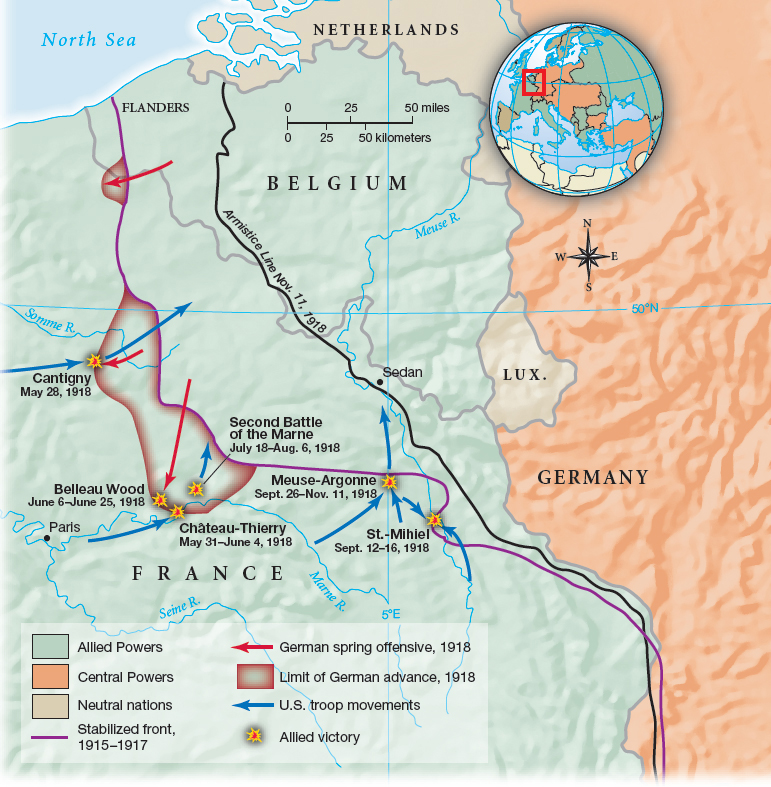The War in France
Printed Page 653
At the front, the American Expeditionary Force (AEF) discovered a desperate situation. The war had degenerated into a stalemate of armies dug into hundreds of miles of trenches that stretched across France. Huddling in the mud among the corpses and rats, soldiers were separated from the enemy by only a few hundred yards of “no-man’s-land.” When ordered “over the top,” troops raced desperately toward the enemy’s trenches, only to be entangled in barbed wire, enveloped in poison gas, and mowed down by machine guns. The three-day battle of the Somme in 1916 cost the French and British forces 600,000 dead and wounded and the Germans 500,000. The deadliest battle of the war allowed the Allies to advance their trenches only a few meaningless miles.
American Expeditionary Force (AEF)
 U.S. armed forces under the command of General John Pershing who fought under a separate American command in Europe during World War I. They helped defeat Germany when they entered the conflict in full force in 1918.
U.S. armed forces under the command of General John Pershing who fought under a separate American command in Europe during World War I. They helped defeat Germany when they entered the conflict in full force in 1918.
Still, U.S. troops saw almost no combat in 1917. The major exception was the 92nd Division of black troops. When Pershing received an urgent call for troops from the French, he sent the 92nd to the front to be integrated with the French army because he did not want to lose command over the white troops he valued more. In the 191 days they spent in battle — longer than any other American outfit — the 369th Regiment of the 92nd Division won more medals than any other American combat unit. Black soldiers recognized the irony of having to serve with the French to gain respect.
White troops continued to train and sightsee until March 1918, when a million German soldiers punched a hole in the Allied lines. Pershing finally committed the AEF to combat. In May and June, at Cantigny and then at Château-Thierry, the eager but green Americans checked the German advance with a series of assaults (Map 22.3). Then they headed toward the forest stronghold of Belleau Wood, moving against streams of retreating Allied soldiers who cried defeat: “La guerre est finie!” (The war is over!). A French officer commanded the Americans to retreat with them, but the American commander replied sharply, “Retreat, hell. We just got here.” After charging through a wheat field against withering machine-gun fire, the Marines plunged into hand-to-hand combat. Victory came hard, but a German report praised the enemy’s spirit, noting that “the Americans’ nerves are not yet worn out.” Indeed, it was German morale that was on the verge of cracking.

CHAPTER LOCATOR
What was Woodrow Wilson’s foreign policy agenda?
What role did the United States play in World War I?
What impact did the war have on the home front?
What part did Woodrow Wilson play at the Paris peace conference?
Why was America’s transition from war to peace so turbulent?
Conclusion: What was the domestic cost of foreign victory?
 LearningCurve
LearningCurve
Check what you know.
In the summer of 1918, the Allies launched a massive counteroffensive that would end the war. A quarter of a million U.S. troops joined in the rout of German forces along the Marne River. In September, more than a million Americans took part in the assault that threw the Germans back from positions along the Meuse River. In November, a revolt against the German government sent Kaiser Wilhelm II fleeing to Holland. On November 11, 1918, a delegation from the newly established German republic met with the French high command to sign an armistice that brought the fighting to an end.
The adventure of the AEF was brief, bloody, and victorious. When Germany had resumed unrestricted U-boat warfare in 1917, it had been gambling that it could defeat Britain and France before the Americans could raise and train an army and ship it to France. The German military had miscalculated badly. By the end, 112,000 AEF soldiers perished from wounds and disease, while another 230,000 Americans suffered injuries but survived. European nations, however, suffered much greater losses: 2.2 million Germans, 1.9 million Russians, 1.4 million French, and 900,000 Britons had been killed. Where they had fought, the landscape was as blasted and barren as the moon.
QUICK REVIEW
Question
How did the American Expeditionary Force contribute to the defeat of Germany?